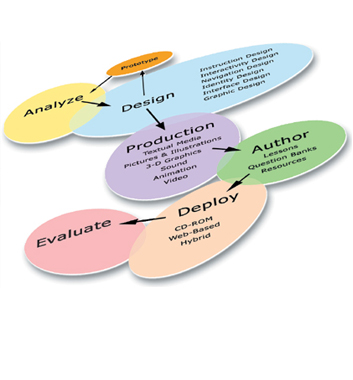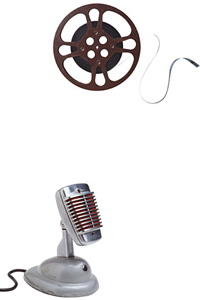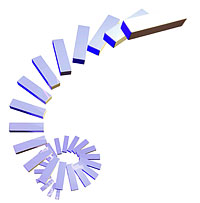| |
|
Our Processes
|
|
MEdRC Design Process and Skillsets
Enticing and visually absorbing multimedia rich content can only be developed by a team that is strong in its research, teaching, designing and communication capabilities. The MEdRC EduTech team adds creativity by adopting a pure design approach to the overall development process. The process itself involves:
1. Design
2. Production of Multimedia Elements
3. Software Development
|

|
|
|
|
Design plays a crucial part in the development of the content. In fact several specialty designers design the content part of the software. MEdRC’s design core team focuses on the following processes during the design stage.
Information Design
The recent explosion in the availability of information has given information design a new role in digital content making. The information designer evaluates how the information shall be packaged – and then decides in what form – text, still or moving pictures, music or voice – best illuminates the information’s overall structure and relationships among its components.
Instruction Design
This deals with the application of scientific principles to develop effective instruction. It is a systematic process for preparing a program of instruction and involves the selection, sequencing and creation of appropriate learning experiences.
The process itself involves 5 steps
-
Analysis : student needs, levels, and desired goals and outcomes
-
Design : lesson plans and learning objects as per defined standards
-
Develop : the blocks of instruction - text, diagrams, videos, animation
-
Implement : pilot implementation followed by scaling up
-
Evaluate : test &
monitor, record results, analyze and revise
Interactivity Design
Interactivity design involves examining two entities and then creating a way for those two to work with one another. In case of interactivity between information forms such as multimedia elements, this becomes the force that binds the whole program together. The mode of such interaction determines the software development process of the application module. This way one module plugs into another without disturbing the harmony of the whole program is engineered.
Navigation Design
How a user would navigate through various contents is decided through a complex process that involves psychological analysis and studies of various browsing patterns on pre-existing systems. Simplification of the choices and offering intelligently pre-determined paths ensure that the end user “travels” through the content in a logical and un-confusing manner. Several models exist for organising the navigation layout – Linear, Hierarchical, Web, Parallel, Matrix, Overlays and Spatially zoom able models may be used within any application.
Identity Design
Identity design is the expression of the vision and intent of the program. The designer’s job is to portray that vision in a pure, efficient form. The mood, and “look and feel” of the program content is decided and recorded into a document that forms the basis of the rest of the design process.
Interface Design
The Graphical User Interface is no longer just functional menus and buttons on a screen. The user actually interacts with the machine as he responds to the physical world. Several successful GUI models have used metaphors such as desktops, rooms, cities or other recognisable environments. We use a “Virtual Classroom” Interface for the E-Learning products.
Graphic Design
Graphics form the basis for the visually appealing nature of any program. The quality of design is determined by several factors, the most important being the quality of graphic designer. Backgrounds, buttons, icons, windows and other such interface elements are designed to reflect both the look and feel for the program as well as to work as fully functional navigation and presentation elements. Design consistency poses a challenge in that it should not amount to boredom.
|
|
|
|
|
|
Each piece of media in a multimedia content production needs to be designed and executed for maximum impact. The place where the media appears and what message it tries to convey have a bearing on the design. Quality of production of various media elements such as text, voice, music and video determine the effectiveness and impact of the presentation as a whole.
Textual Media
Text is used in several forms. Text to be displayed on the screen has to be laid out as per set guidelines for maximum legibility and use. Text scripts meant to be spoken, as voice-overs have to be written in a specific tone by writers who specialise in script writing. Creative writers may contribute to the overall value that any piece has to offer. Writers who specialise in Medical Writing could add tremendous value to content meant for the UGMed courseware. Video scriptwriters undertake writing for video and such scripts also dictate what visual should accompany every segment of voice-over.
Software: MS Office, Lotus SmartSuite, HTML Editors
Pictures
Image quality depends on quality of photographer employed, the equipment he uses, and the quality of scanning equipment used to digitize the pictures. Digital photography and the use of mid-high end flatbed scanners is preferable. Image processing techniques such as colour correction, value enhancements and masking takes considerable time and effort and give dramatic results in the hands of a professional digital artist.
Equipment : Canon EOS 350D Digital SLR’s with all accessories
Sony Mavica Digital Cameras, HP Flatbed Scanners,
HP PhotoSmart 35mm Slide Scanners
Software : Adobe Photoshop, Fractal Painter, gIMP
3-D Graphics
3 dimensional graphics are used as stills or animation in various situations. These are made by creating wire frame mesh of an object and ‘wrapping’ scanned or created textures on them. It also involves lighting and rendering of the wire frames to create images.
Software: MAYA, Kinetics 3D Studio MAX
Sound
Voice and music are the two commonest audio elements used in a program. Sound effects may also be used if required to achieve a purpose. Sound is recorded in special sound recording studios using high-end studio microphones and mixers to achieve maximum effect. Finally audio may be edited and compressed and down-sampled for final delivery. Music may be bought or composed. Alternatively royalty free stock music is available as libraries for free use.
Software: Adobe Audition, Sound Forge, Cakewalk, Windows Media, Royalty free Stock CDs
Video Production
MEdRC owns a full-fledged television studio for shooting educational video films on DVCAM and Betacam-SP formats. The TV studio has state-of-the-art sound and lighting systems for high-quality productions. Equipment and crew may be hired on a daily basis for both studio and outdoor productions. The digital video edit suites are equipped with broadcast quality non-linear video editing equipment for digitizing, video mixing, titling and audio-dubbing. Editing is done on a non-linear computer system and after final mixing with the audio tracks, the video clips are rendered using compression codecs to achieve desired quality and performance.
Equipment: Sony Broadcast Cameras DSR-300P and DV Cameras Panasonic 102B, AG62 and Sony DSR-100, Panasonic 2500 Decks DVCAM DSR 80P Deck, Betacam SP UVW 1400AP Deck,
SHURE Microphones
Digital Editing : DPS Perception and Matrox RTX based Non-linear Edit Suites, Pinnacle, Darim MPEGator, ASUS Video Capture, DVD Authoring
Formats : Betacam-SP, DVCAM, MiniDV, Digital Hi-8, SVHS and VHS. Disks : VCD, SVCD, DVD
Software: Adobe Creative Suite, DPS Reality and Velocity, Adobe Premiere Pro, Adobe After Effects, Ulead Video Editor, Real Producer, Apple Quicktime, Windows Media Encoder, DVD Authoring
Multimedia Authoring
Powerful multimedia authoring software are used to develop multimedia products like CDs and CBT courseware. These software let us package all the blocks like text, pictures and video into meaningful lessons. Similarly Web Authoring tools allow for content to be packed as “web pages’ for delivery.
Software: SmarTeach – MEdRC’s e-Learning Engine
(> 500 man months of effort) Also support: Macromedia Director, Macromedia Authorware, Macromedia Flash, Macromedia Dreamweaver, Macromedia Fireworks, Microsoft Frontpage
|
|

|
|
|
|
The software division of MEdRC EduTech Ltd has skills in core Microsoft Technologies (ASP, VB, .Net technologies, Flash Actionscript etc). The team has been involved with the development of the SmarTeach authoring and distribution engines since October 2000 and is committed to the long-term enhancements and support of the product. The team members have earlier worked on several multi-media based kiosk solutions, web-based enterprise solutions and transactional software.
Hardware: > 50 workstations (Windows XP, Win 98)
Servers: IBM x-Series 260 and 220, DELL PowerEdge 2400
Software: Windows Server 2003, Windows XP/98/NT/2000, Windows Storage Server 2003, Visual Studio .Net, SQL Server 2005. Flash ActionScript 3.0, Flash Media Interactive Server, DotNet, AJAX, Web Services, XML, Media Streaming.
|
|

|
|


